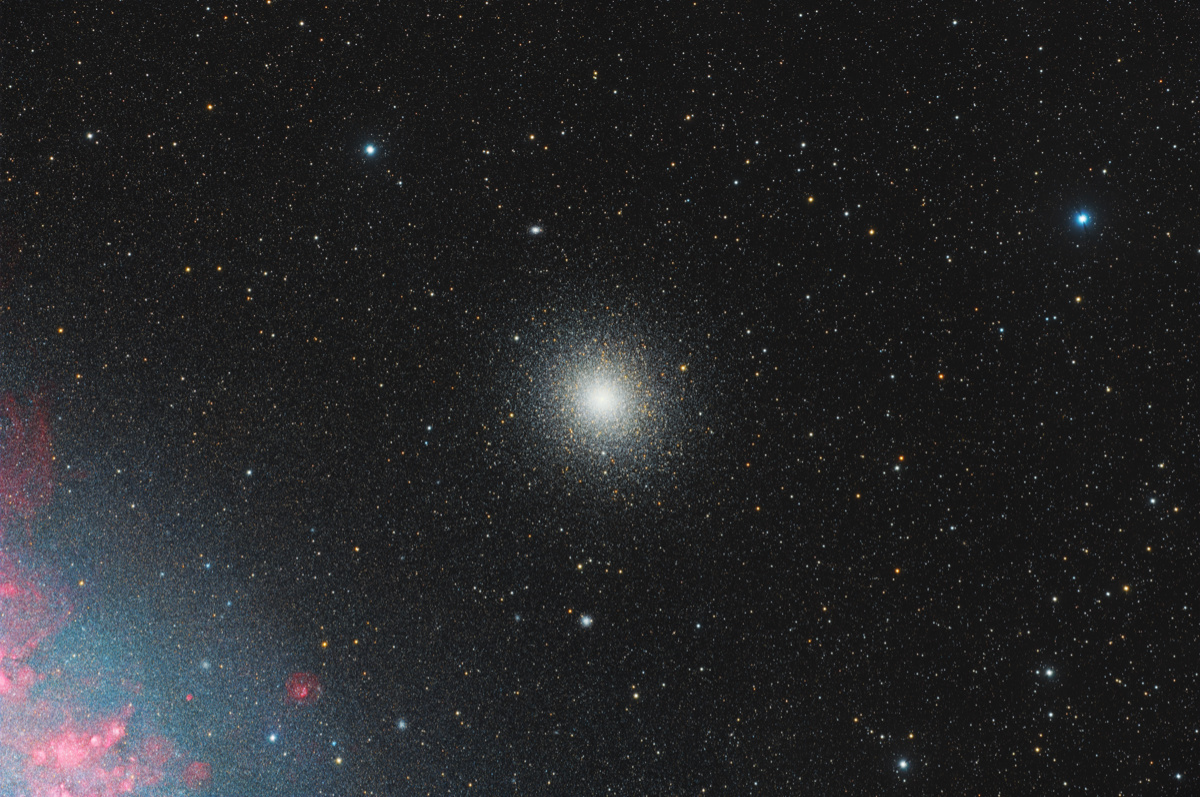
[back] Wide field of NGC 104 (47 Tuc) in Tucana[NED]
Higher resolved image /
höher aufgelöstes Bild (9500 x 6304 Pixel)
Annotated version of image

|
Concentration Class III. |
|
0.5° |
|
(c) 2024 All astro photo images are copyrighted. They may not be used or reproduced without explicit written permission from the authors.
About this Image / Über dieses Bild
| Camera: | Moravian C3-PRO-61000 Mono CMOS |
| Image Type, Orientation: | L-RGB-Ha Color Composite, North is at 12:00 |
| Exposure time: | L: 63*300 sec., R,G: 23*300 sec. each, B: 25 * 300s, Ha: 39*300 sec. (15:25h total) |
| Exposure date: | November 2023 |
| Location: | Capella Observatory South at Kiripotib Astro Farm, Namibia |
| Filter: | Astronomik Deep-Sky Deep-Sky RGB Filter plus 6nm Ha filter on Moravian EFW-3L-9-II External Filter Wheel |
| Instrument: | "Callisto", a Takahashi FSQ 106N, 530mm focal length, 106mm aperture, f/5 on modified Losmandy G11 (high res encoders with OnStepX) |
| Photographer: | Rainer Raupach, Josef Pöpsel, Frank Sackenheim |
| Remarks: |
47 Tucanae (also known as NGC 104) is the apparently
second brightest globular cluster in the sky after Omega Centauri. Because
of its compact shape, it was initially mistaken for a star and accordingly
labeled. Also in reality, its center exhibits an extremely high density of stars, with over 6 stars per square arcsecond [1], equivalent to >1200 stars per square light-year when converted to its distance of approximately 14700 light years. In combination with the radial density distribution, this suggests that the stars in the center are less than 0.1 light years apart, which is 40 times closer than the distance from the nearest fixed star to the Sun. Within a radius of about 75 light years, there are several million stars, including luminous red giants, which are easily identifiable by their color in the image. Considering how prominent a red giant like Betelgeuse appears from Earth at a distance of about 500 light years, one can only vaguely imagine the spectacle that several million stars, including numerous red giants, would present in a much smaller volume of space. The globular cluster hosts at least ten millisecond pulsars, most of which are part of binary star systems [2]. Therefore, 47 Tuc is also visible in the gamma-ray window. In the lower left corner, the Small Magellanic Cloud joins the scene, although it is significantly farther away at approximately 200,000 light-years, making it only appear to be close to 47 Tuc. By incorporating narrowband data, the emission nebulae in this irregular galaxy stand out nicely. |
|
|
|
| Bemerkungen: |
47 Tucanae (heute auch NGC 104)
ist nach Omega Centauri der scheinbar zweithellste Kugelsternhaufen am
Himmel. Wegen seiner kompakten Form wurde er zunächst als Stern angesehen
und deswegen entsprechend bezeichnet.
|
Back to the Globular Clusters Overview / Zurück zur Kugelsternhaufen-Übersichtsseite